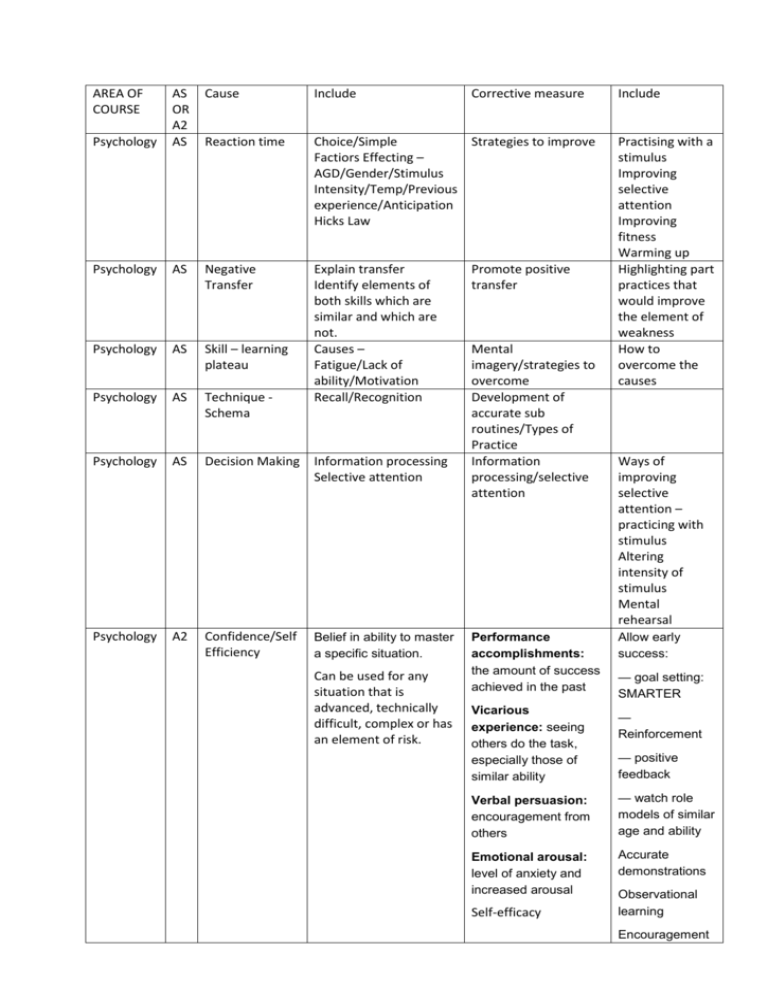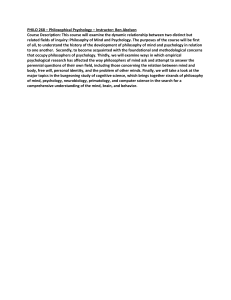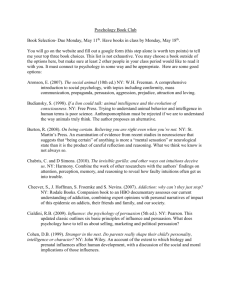examples of C1 and C2 Psychology
advertisement

AREA OF COURSE Cause Include Psychology AS OR A2 AS Reaction time Choice/Simple Strategies to improve Factiors Effecting – AGD/Gender/Stimulus Intensity/Temp/Previous experience/Anticipation Hicks Law Psychology AS Negative Transfer Psychology AS Skill – learning plateau Psychology AS Technique Schema Explain transfer Identify elements of both skills which are similar and which are not. Causes – Fatigue/Lack of ability/Motivation Recall/Recognition Psychology AS Decision Making Information processing Selective attention Psychology A2 Confidence/Self Efficiency Belief in ability to master a specific situation. Can be used for any situation that is advanced, technically difficult, complex or has an element of risk. Corrective measure Promote positive transfer Mental imagery/strategies to overcome Development of accurate sub routines/Types of Practice Information processing/selective attention Include Practising with a stimulus Improving selective attention Improving fitness Warming up Highlighting part practices that would improve the element of weakness How to overcome the causes Ways of improving selective attention – practicing with stimulus Altering intensity of stimulus Mental rehearsal Performance accomplishments: the amount of success achieved in the past Allow early success: Vicarious experience: seeing others do the task, especially those of similar ability — Reinforcement Verbal persuasion: encouragement from others — watch role models of similar age and ability Emotional arousal: level of anxiety and increased arousal Accurate demonstrations Self-efficacy — goal setting: SMARTER — positive feedback Observational learning Encouragement praise Attribute success internally Anxiety control measures: Psychology A2 Anxiety Psychology A2 Psychology A2 Personality (too quiet) Arousal Level Psychology A2 Effect of audience: Lack of confidence self efficacy Cognitive learner facilitation/inhibition Zajonc: Audience watching Increased arousal Dominant response Expert well learned = facilitation Mental rehearsal/visualisation Social learning theory (increase confidence) Strategies to keep arousal to optimum Train with a crowd Increase size of audience early Set achievable goals Allow success Gradually introduce evaluation Evaluation apprehension Relaxation techniques Complex/simple skill Imagery Social facilitation Self talk Block out crowd/selective attention Observational learning AS Cognitive stage of learning Lack of experience Psychology A2 Anxiety: negative aspect of stress, irrational thinking/worry. Trait: innate, consistent, enduring State: temporary situation specific — “if you have the trait, you’re more likely to get the state” Somatic: physiological Visualisation techniques – see chapter within text book SPORT principle Introduce audience at training Novice not developed = inhibition Psychology — relaxation Apply the SPORT Principles Progressive relaxation Biofeedback Breathing control Centering Thought stopping Positive self-talk Visualisation Cognitive: psychological; Imagery anxiety Mental practice Goal setting Practice applying the SPORT principle Practice applying the SPORT principle Psychology A2 Aggression Definitions Types of Aggression Instinct Theory Frustration/Aggression Hypothesis Social Learning Aggression Cue Hypothesis Cognitive – positive self talk Imagery Somatic – progressive muscular relaxation Deep breathing Coaches – specific Praise/feedback strategies Activities related to SPORT AREA OF COURSE Skill Acquistion AS OR A2 AS Cause Include Corrective measure Selective attention: this is appropriate for skills that are ‘open’, where you need to make decisions or choices, where there may be distractions, or where you need to concentrate on a particular aspect of the task. Occurs in perceptual mechanism Train with a distraction After information is collected by the senses Filters code information into relevant and irrelevant Mental practice Practise to the stimulus Motivate to improve alertness Focus and concentrate Make the stimulus intense Is useful because it prevents overload of information Memory has only limited capacity Allows performer to focus on weakness or technical point Skill Acquistion Skill Acquistion AS AS Lack of motivation: appropriate when the skill requires a real effort, when there is energy and drive required, when there is an opportunity to extend the skill. In contact situations or where an exertion of energy is required such as in a swim race start, tennis serve, rugby tackle. Plateau: appropriate for skills that can be extended. Skills that you have The drive needed to complete the task Rewards Extrinsic Make it fun Tangible Point out role models Intangible Set realistic, challenging goals Intrinsic Positive reinforcement Positive feedback Attribute success internally Vary practice Boredom Extend the task Fatigue Rewards/reinforcement Lack of motivation Vary practice Include done in the same way for a long time. Skills that are standard. Goals set too low Set new/realistic goals Poor coaching Explain the plateau concept Extent of skill, limit of ability Change coach Plateau concept not explained Skill Acquisition AS Transfer of Training: this topic is useful to explain any skill or tactic that you find hard to transfer from practise into the game. Definition effect of learning Realism Positive aids Learn skill well before making progress Negative hinders Point out transfer possibilities Zero no impact Make slow, planned progression Bilateral limb to limb Use of reinforcement Near — realistic Far — not realistic to game Proactive Retroactive Skill Acquisition AS Memory: this topic is useful for tactics and strategies that you might forget to execute during the game. You may have received coaching advice or feedback that you fail to act on because you forget it. Short-term sensory store: Picks up info from display Filters relevant from irrelevant — selective attention Large capacity Lasts for fraction of a second Short-term memory: Picks up relevant info Practice/rehearsal Mental practice Chunking Association with other info Make info bright/intense Focus/concentrate Working memory Limited capacity — 7 items Initiates motor programme Stores a memory trace Passes rehearsed info to LTM If not practiced, info is lost Retrieves programme s from LTM Long-term memory: Endless capacity Stores motor programme s Lasts a lifetime Sends programmes to STM




